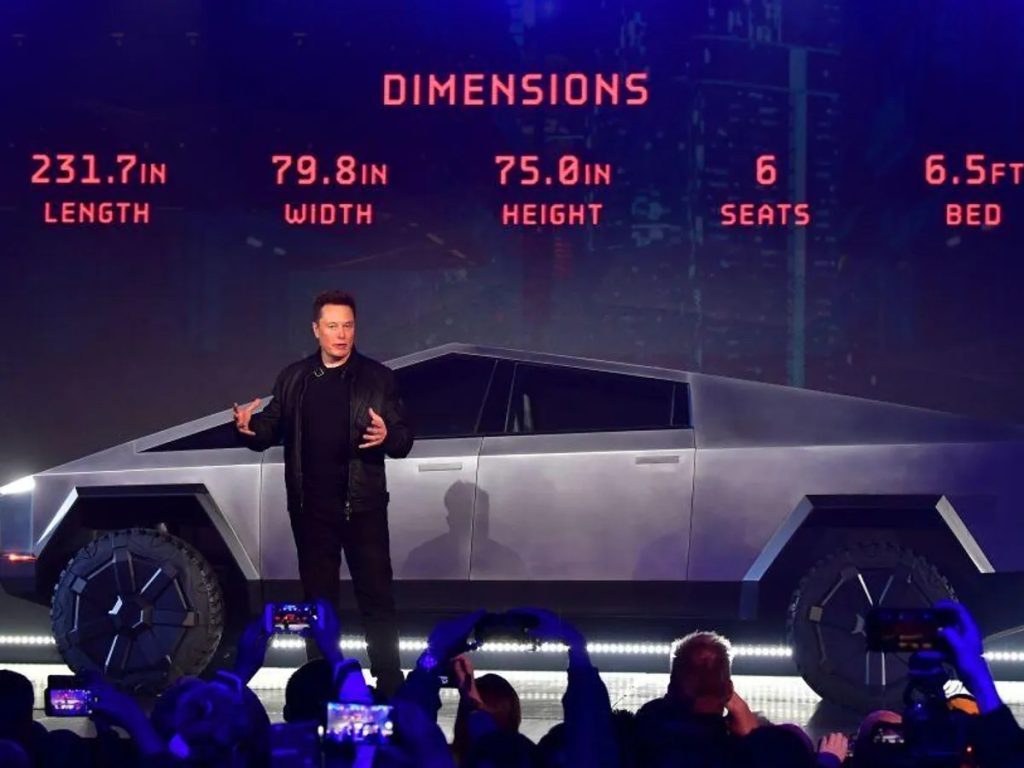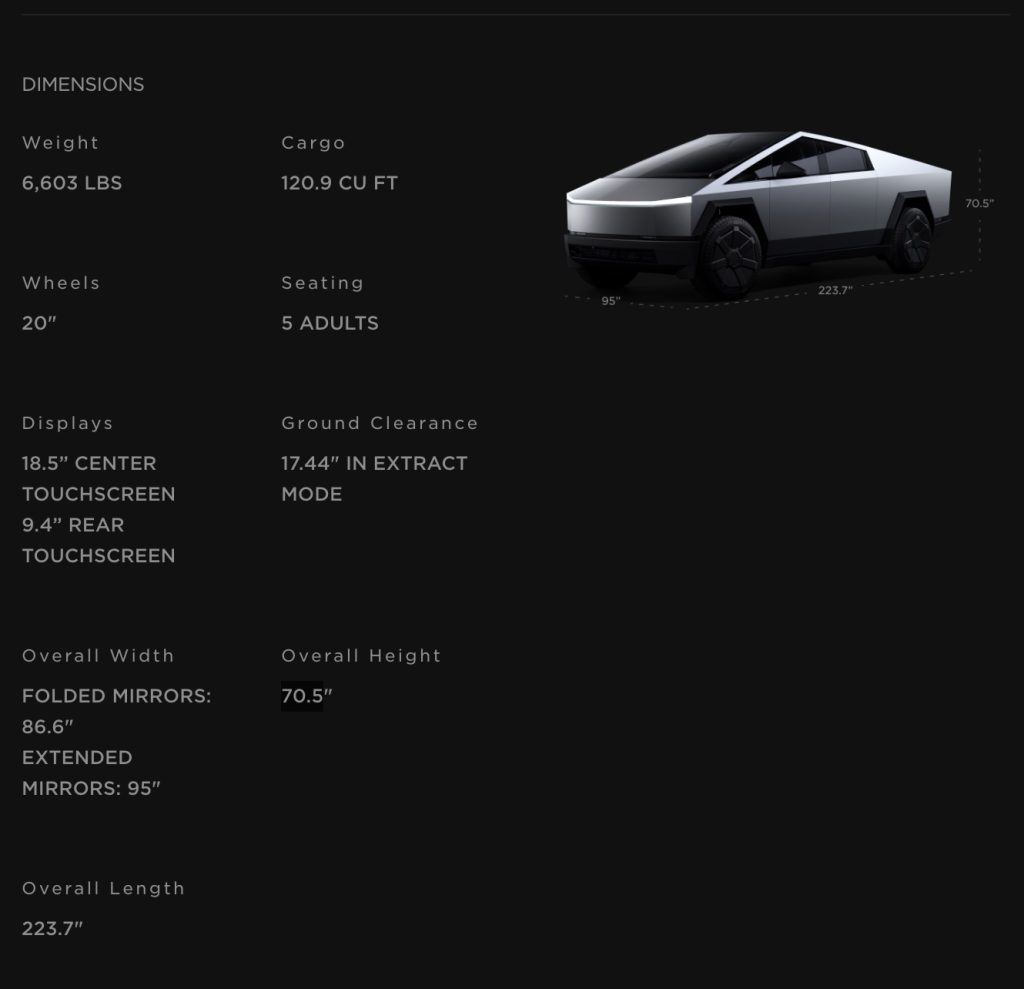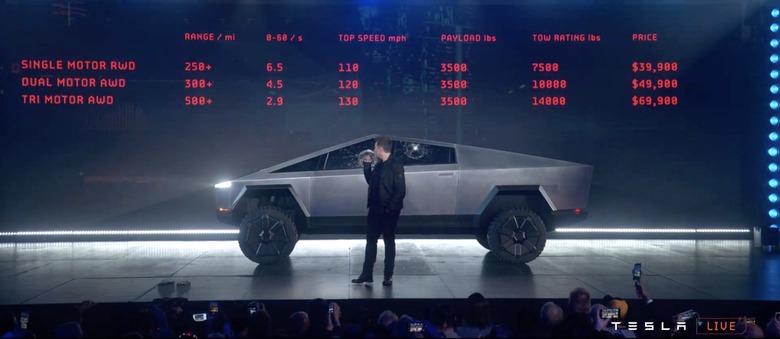

News
Tesla Cybertruck production has arrived: Here’s how it compares to its 2019 prototype
The Tesla Cybertruck production specs are here, and they are quite a bit different from the figures that were announced for the vehicle back in late 2019. From the size of the Cybertruck’s bed to its dimensions and range, the changes that were implemented on the pickup truck over the years are quite notable.
Whether or not these changes are ultimately for the better would be up for consumers to decide, of course. But for reference, here is a quick comparison of how the production Tesla Cybertruck compares to its hulking original prototype from 2019 — the prototype which, in a lot of ways, caused the auto industry to take a second look at Tesla’s sanity.
Dimensions
The original Cybertruck prototype from 2019 was a hulking steel beast that was announced with a length of 231.7 inches, a width of 79.8 inches, and a height of 75 inches. The production Cybertruck, as per Tesla’s official page for the vehicle, now has an overall length of 223.7 inches, a width of 86.6 inches with the mirrors folded, and an overall height of 70.5 inches.


Payload
Being a pickup truck, it is pertinent for the Cybertruck to have a decent payload capacity. The original prototype from 2019 was listed with a payload capacity of 3,500 pounds. During the Cybertruck delivery event, Elon Musk noted that the vehicle now features a payload capacity of 2,500 pounds. Musk did not, however, clarify if the 2,500-pound payload capacity was standard for all the Cybertruck’s variants.
Range
Range is among the production Cybertruck’s most notable areas of complaints from the EV community. During its 2019 debut, Tesla announced that the Cybertruck will have a range of 250+ miles for the RWD version, 300+ miles for the Dual Motor AWD version, and 500+ miles for the Tri-Motor variant. The production Cybertruck listed in Tesla’s updated website with a range of 250 miles for the RWD variant, 340 miles for the Dual Motor version, and 320 miles for the top-tier “Cyberbeast.”
Tesla did list a range extender option for the Cybertruck Dual Motor and the Cyberbeast. With the range extender, the Dual Motor could have a range of 470+ miles, and the Cyberbeast will have a range of 440+ miles. Overall, Tesla definitely missed its target with the Cyberbeast’s range, but the company did hit its target for the Dual Motor and RWD variants.


Towing
Back in 2019, the original Cybertruck’s RWD variant was listed with a towing capacity of 7,500 pounds, the Dual Motor was listed with a towing capacity of 10,000 pounds, and the Tri-Motor was listed with a towing capacity of 14,000 pounds. The production Cybertruck is currently listed with a towing capacity of 7,500 for its RWD version, and 11,000 pounds for both the Dual Motor and Cyberbeast trims.
Price
Tesla shocked attendees of the Cybertruck’s 2019 unveiling event when it announced that the base RWD version of the all-electric pickup truck will start at $39,990. At the time, the Dual Motor was listed at $49,990, and the Tri-Motor variant was listed with a price of 69,990. The production Cybertruck, as per Tesla’s configurator today, costs $60,990 for its RWD version, $79,990 for its Dual Motor variant, and $99,990 for its top-tier Cyberbeast trim.
Performance
During its 2019 unveiling, the original Cybertruck prototype was announced with a 0-60 mph time of 6.5 seconds for its RWD version, 4.5 seconds for its Dual Motor variant, and 2.9 seconds for its Tri-Motor trim. Top speed was also listed at 110 mph for the Cybertruck RWD, 120 mph for the Cybertruck Dual Motor, and 130 mph for the Cybertruck Tri-Motor.
Today, the production Cybertruck is listed with a 0-60 mph time of 6.5 seconds for its RWD version, 4.1 seconds for the Dual Motor variant, and 2.6 seconds for the Cyberbeast. The top speed for the production Cybertruck Dual Motor is now listed at 112 mph, and the Cyberbeast is listed with a 130 mph top speed.
Storage
Back in 2019, the original Tesla Cybertruck was announced with 100 cubic feet of exterior storage. Its bed was also 6.5 feet in length. During the recently-held Cybertruck delivery event, Elon Musk noted that the all-electric pickup truck now features a bed that’s 6 feet long and 4 feet wide. Tesla’s official page for the Cybertruck also mentions that the vehicle features “67 cubic feet of lockable storage.”
Tesla has noted that the Cybertruck experienced changes as it headed towards production. The vehicle’s size has definitely been affected, and so has the pickup truck’s storage capacity. It would now be quite interesting to see how the Tesla Cybertruck fares in the market as it competes against popular combustion-powered trucks and electric pickups like the Rivian R1T and the Ford F-150 Lightning.
Don’t hesitate to contact us with news tips. Just send a message to simon@teslarati.com to give us a heads up.

News
Tesla FSD fleet is nearing 7 billion total miles, including 2.5 billion city miles
As can be seen on Tesla’s official FSD webpage, vehicles equipped with the system have now navigated over 6.99 billion miles.

Tesla’s Full Self-Driving (Supervised) fleet is closing in on almost 7 billion total miles driven, as per data posted by the company on its official FSD webpage.
These figures hint at the massive scale of data fueling Tesla’s rapid FSD improvements, which have been quite notable as of late.
FSD mileage milestones
As can be seen on Tesla’s official FSD webpage, vehicles equipped with the system have now navigated over 6.99 billion miles. Tesla owner and avid FSD tester Whole Mars Catalog also shared a screenshot indicating that from the nearly 7 billion miles traveled by the FSD fleet, more than 2.5 billion miles were driven inside cities.
City miles are particularly valuable for complex urban scenarios like unprotected turns, pedestrian interactions, and traffic lights. This is also the difference-maker for FSD, as only complex solutions, such as Waymo’s self-driving taxis, operate similarly on inner-city streets. And even then, incidents such as the San Francisco blackouts have proven challenging for sensor-rich vehicles like Waymos.
Tesla’s data edge
Tesla has a number of advantages in the autonomous vehicle sector, one of which is the size of its fleet and the number of vehicles training FSD on real-world roads. Tesla’s nearly 7 billion FSD miles then allow the company to roll out updates that make its vehicles behave like they are being driven by experienced drivers, even if they are operating on their own.
So notable are Tesla’s improvements to FSD that NVIDIA Director of Robotics Jim Fan, after experiencing FSD v14, noted that the system is the first AI that passes what he described as a “Physical Turing Test.”
“Despite knowing exactly how robot learning works, I still find it magical watching the steering wheel turn by itself. First it feels surreal, next it becomes routine. Then, like the smartphone, taking it away actively hurts. This is how humanity gets rewired and glued to god-like technologies,” Fan wrote in a post on X.
News
Tesla starts showing how FSD will change lives in Europe
Local officials tested the system on narrow country roads and were impressed by FSD’s smooth, human-like driving, with some calling the service a game-changer for everyday life in areas that are far from urban centers.

Tesla has launched Europe’s first public shuttle service using Full Self-Driving (Supervised) in the rural Eifelkreis Bitburg-Prüm region of Germany, demonstrating how the technology can restore independence and mobility for people who struggle with limited transport options.
Local officials tested the system on narrow country roads and were impressed by FSD’s smooth, human-like driving, with some calling the service a game-changer for everyday life in areas that are far from urban centers.
Officials see real impact on rural residents
Arzfeld Mayor Johannes Kuhl and District Administrator Andreas Kruppert personally tested the Tesla shuttle service. This allowed them to see just how well FSD navigated winding lanes and rural roads confidently. Kruppert said, “Autonomous driving sounds like science fiction to many, but we simply see here that it works totally well in rural regions too.” Kuhl, for his part, also noted that FSD “feels like a very experienced driver.”
The pilot complements the area’s “Citizen Bus” program, which provides on-demand rides for elderly residents who can no longer drive themselves. Tesla Europe shared a video of a demonstration of the service, highlighting how FSD gives people their freedom back, even in places where public transport is not as prevalent.
What the Ministry for Economic Affairs and Transport says
Rhineland-Palatinate’s Minister Daniela Schmitt supported the project, praising the collaboration that made this “first of its kind in Europe” possible. As per the ministry, the rural rollout for the service shows FSD’s potential beyond major cities, and it delivers tangible benefits like grocery runs, doctor visits, and social connections for isolated residents.
“Reliable and flexible mobility is especially vital in rural areas. With the launch of a shuttle service using self-driving vehicles (FSD supervised) by Tesla in the Eifelkreis Bitburg-Prüm, an innovative pilot project is now getting underway that complements local community bus services. It is the first project of its kind in Europe.
“The result is a real gain for rural mobility: greater accessibility, more flexibility and tangible benefits for everyday life. A strong signal for innovation, cooperation and future-oriented mobility beyond urban centers,” the ministry wrote in a LinkedIn post.
News
Tesla China quietly posts Robotaxi-related job listing
Tesla China is currently seeking a Low Voltage Electrical Engineer to work on circuit board design for the company’s autonomous vehicles.

Tesla has posted a new job listing in Shanghai explicitly tied to its Robotaxi program, fueling speculation that the company is preparing to launch its dedicated autonomous ride-hailing service in China.
As noted in the listing, Tesla China is currently seeking a Low Voltage Electrical Engineer to work on circuit board design for the company’s autonomous vehicles.
Robotaxi-specific role
The listing, which was shared on social media platform X by industry watcher @tslaming, suggested that Tesla China is looking to fill the role urgently. The job listing itself specifically mentions that the person hired for the role will be working on the Low Voltage Hardware team, which would design the circuit boards that would serve as the nervous system of the Robotaxi.
Key tasks for the role, as indicated in the job listing, include collaboration with PCB layout, firmware, mechanical, program management, and validation teams, among other responsibilities. The role is based in Shanghai.
China Robotaxi launch
China represents a massive potential market for robotaxis, with its dense urban centers and supportive policies in select cities. Tesla has limited permission to roll out FSD in the country, though despite this, its vehicles have been hailed as among the best in the market when it comes to autonomous features. So far, at least, it appears that China supports Tesla’s FSD and Robotaxi rollout.
This was hinted at in November, when Tesla brought the Cybercab to the 8th China International Import Expo (CIIE) in Shanghai, marking the first time that the autonomous two-seater was brought to the Asia-Pacific region. The vehicle, despite not having a release date in China, received a significant amount of interest among the event’s attendees.








